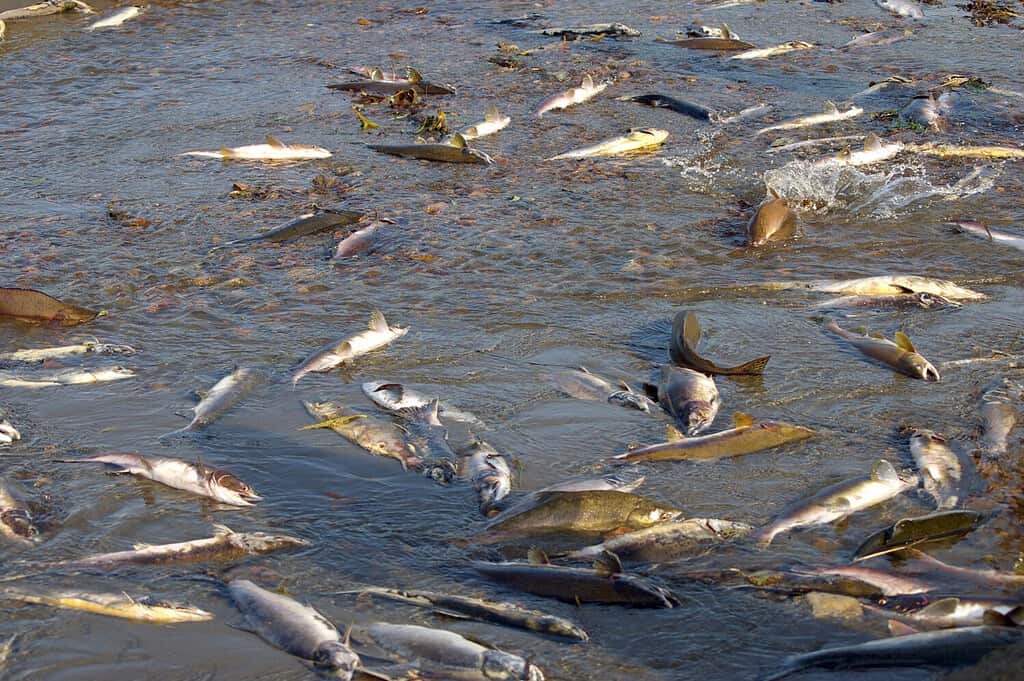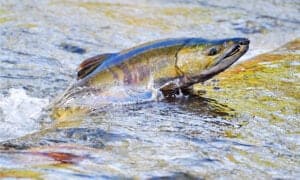Salmon undergo huge migrations to the sea as juveniles and back up into their home streams to spawn at the end of their lives. As they travel, their bodies change. What is a zombie salmon? Why do they exist? What they are and where they live is explained in detail.
What Is a Zombie Salmon?

Zombie salmon are dying adults at the end of their lives after spawning in river systems.
©cweimer4/iStock via Getty Images
Zombie salmon are dying salmon at the end of their migratory journey and life cycle. When migrating salmon reach fresh water, they stop eating completely and survive solely on their oil and fat stores. Their only goal is to stay alive until they spawn.
Due to the stressors of traveling such a long way upstream, once they reach freshwater, their bodies fall apart after they spawn. Their muscles degenerate because they are metabolized as they are starving, their organs start shut down, and they openly decompose even though they aren’t completely dead. As a consequence, they’re still alive, but they are quite literally rotten, much like zombies in pop lore.
Male salmon develop huge snaggly teeth that they use in competition when mating, and the females put all of their bodily resources into creating as many healthy eggs as possible. Not only does their body rot, their immune system becomes nonexistent. This allows mold and bacteria to start taking over even though they’re alive enough to move around.
Where do Zombie Salmon Live?
Zombie salmon live in freshwater rivers and streams during the fall salmon migration. They originate in the oceans and climb through rivers in the North Pacific and North Atlantic Oceans. While almost all Pacific salmon turn into zombies and don’t return to the ocean, up to ten percent of Atlantic salmon do make it back for another spawning run the next year.
As salmon travel farther upstream, they become more zombified as their bodies deteriorate. As a result, the farther away a freshwater spawning spot is from the ocean, the more zombie-esque the live salmon will be.
When a salmon is fully finished spawning, their zombie status kicks into high gear. They look like dead fish that are swimming, and they are often still alive when they look like they couldn’t possibly be. They live like this for a few days, though some last a week or more in this zombified state.
What Benefits From the Existence of Zombie Salmon?

The rotting bodies of zombie salmon provide freshwater ecosystems with needed nutrients.
©RedTC/Shutterstock.com
The entire freshwater ecosystem containing zombie salmon, especially riparian environments, benefits from the imminent deaths of these fish. They die so densely in certain spots that they can litter the entire bottom of the waterway. As they decompose or are consumed, their body’s remaining nutrients, sourced from the faraway ocean, become accessible.
Scavenging animals benefit greatly from zombie salmon as they make easy pickings. Even salmon offspring that the adults worked so hard to spawn may take advantage of their body remnants when the time comes. The plant life where zombie salmon die gets to take advantage of minerals and nutrients from the ocean that they usually aren’t exposed to in abundance.
What Animals Rely on Eating Zombie Salmon?

Birds of prey like ospreys take full advantage of zombie salmon.
©Gregory Johnston/Shutterstock.com
Direct predation of pre and post-spawning salmon by bears, wolves, river otters, and other direct consumers in rivers is common. Sea lions and seals are spotted farther up into freshwater systems each year and pose a threat to the number of salmon that make it upstream to die after spawning. Regardless of whatever life phase a salmon is in, it is considered a keystone species in many ecosystems.
The results of direct predation spread salmon body parts into the surrounding landscape to rot for terrestrial species. Birds of prey, like eagles, spread the carcasses even farther away from the fish source. This also provides nutrients to the soil, not usually attained by normal leaf litter and decay.
The juvenile salmon that result from the spawning also rely on the bodies of their parents to strengthen them for their journeys to the ocean. Directly and indirectly, bird species like ospreys, common mergansers, Caspian terns, and harlequin ducks all rely on the supply of salmon bodies at the end of the spawning run.
Can Humans Eat Zombie Salmon?
Most humans do not eat zombie salmon, though it isn’t impossible if it’s cooked thoroughly at a high temperature. These fish are often so close to dying that they can be caught by hand. Their flesh sometimes mushes off as jelly when grabbed. They usually stink and can sometimes be covered in mold.
It’s also sometimes hard to distinguish between a true, barely alive zombie salmon and a dead fish. If you eat a fish that’s harvested dead, the chances of getting sick are greatly raised.
Most fishermen state that the risks of eating them aren’t worth the rewards. If more people saw what salmon look like as zombies, no one would question why they shouldn’t be consumed.
The photo featured at the top of this post is © Kevin Cass/Shutterstock.com
Thank you for reading! Have some feedback for us? Contact the AZ Animals editorial team.







